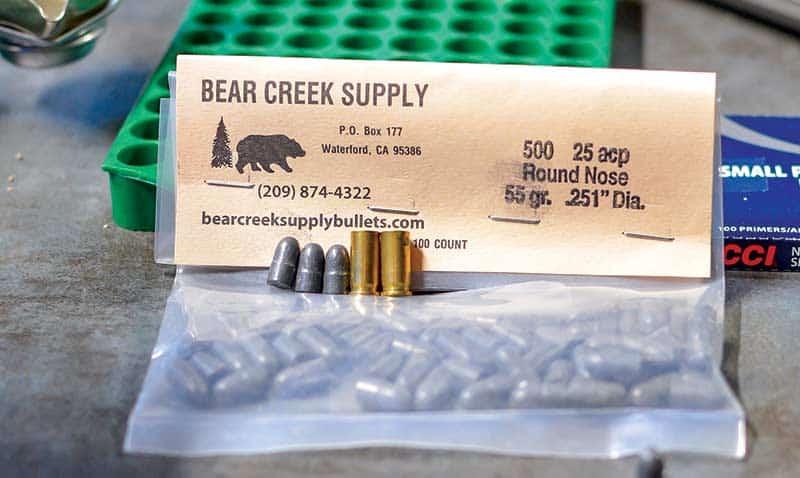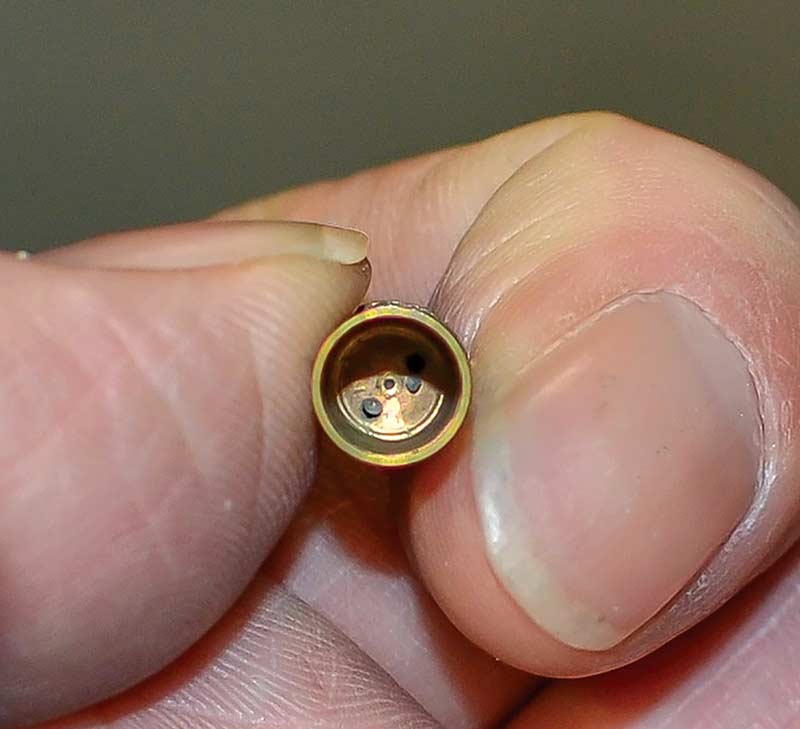.25 ACP: Labor Of
Love Or Insanity?
I like to push my reloading hobby to extremes. Most reloaders don’t bother with the .25 ACP, but if you incorporate a few tips, you can make accurate and reliable baby cartridges.
The Amazing (Or Not) .25 ACP
Sometimes, just for fun, I go to my local range or gun store and talk about the terminal effectiveness of the .25. While I’ve carried a .25 ACP as a third gun, it’s not exactly my recommended defensive cartridge. Let’s fuel this fire.
As a police officer, I’ve had plenty of cases where mouse guns were used in a crime. Two such cases stand out. One was a drive-by where the victim reported to the hospital with a bullet lodged near his heart. It was definitely a .25 ACP bullet, but had flown through the steel doorpost of an ’80s-era vehicle and his bicep near the shoulder, until it stopped at its not quite fatal position. I was thinking the same thing the emergency physician voiced: “A .25 Auto did that?”
The second case was a man shot five times in the chest after his ex-girlfriend lured him out to an orchard to shoot him. He telephoned dispatch and calmly directed an ambulance to his location. He recovered and walked out of the hospital the next day.
Reloading Secrets
Handle components as little as possible. If you don’t have a turret press, this is your encouragement to get one. There’s no single tool that can reduce cartridge handling besides a dedicated progressive machine, but many accessories, like automatic case feeders, don’t work with .25.
The Redding T-7 has outstanding rigidity, and the open area gives plenty of room for fumbling hands like mine, but its greatest quality is the sensitivity — you’ll need it for priming the .25. The Lee Precision Carbide 3 Die set I use comes with a powder through expanding die, a critical component of .25 Auto reloading.
If you’ve been reloading for any length of time, you can see where I’m going. Put the brass in only once. Size, then prime on the downstroke. Index to the expander die. Expand, then drop in your powder while the brass is fully inserted into the die. Index to the seating die. Seat a bullet.
The .25 ACP brass is tiny. You don’t want to overhandle it.
When I load .25 Auto, I use two scales: beam and digital. If we used conventional reloading rules like, “Begin at a recommended weight. Increase the load in 10% increments,” a single increase could be disastrous. For a .25 Auto, use increments less than 5% only. You’ll need something that can distinguish tenths of a grain. The digital scale is for monitoring and weighing the finished product.
Measure using volume, inspect with weight. I have an old Redding powder measure similar to the current Competition Powder Measure. It has a micrometer adjustment that, once set, can throw more accurate loads than I can trickle into the pan. I set it to the desired weight, then continually check the throw. For my .25, I used Unique, which is a lot harder to meter than something like AA#2. I measure with my beam scale, set the powder measure, and spot check often.
Component Choices
When you choose a powder to use for reloading a .25 auto, you’ll almost always need to use a fast powder. There really isn’t a lot of capacity for a slower powder, nor do most .25s provide enough barrel for a complete ignition of a slower powder. Fast powders and a small burning chamber can be a recipe for disaster. I picked Unique because it is relatively fast burning but gives the user a wider margin for experimenting. Most .25 Auto loads will get you to around 90% case capacity, which is one reason why .25s are often consistent across a chronograph. You’re looking for speeds around 725-770 fps.
There are even fewer manufacturers of bullets or molds in .25 Auto. My “go to” place for bullets when I’m not pouring my own is Bear Creek Bullets in Waterford, Calif. makes a 55-grain LRN that loads, feeds, and stabilizes well. Their proprietary lube is unique, and they’ve catered to competitive shooters for three decades. Bear Creek’s owner Steve will tell everyone he taught me to shoot. If he wishes to claim my poor shooting, I’m okay with that.
One must really love reloading to tackle the tiny .25, but believe me, it’s worth it.
More info: BearCreekSupplyBullets.com






